Complete Guide To Turkey Tail Mushroom (Trametes versicolor)
Contents
- Meet the Turkey Tail Mushroom
- Turkey Tail Mushroom: Traditional Medicinal Uses
- Turkey Tail Mushroom Benefits
- Identifying and Harvesting Wild Turkey Tail
- Growing Turkey Tail at Home
- Turkey Tail Dosage and Use
- Turkey Tail Mushroom Side Effects and Risks
- Is Turkey Tail an Edible Mushroom?
- Make Turkey Tail Mushroom Part of Your Day
Turkey tail mushroom is a medicinal powerhouse that has long been prized for its effects on immunity, inflammation, infections and more.
It’s not hard to find the eye-catching fan-shaped formations of turkey tail mushroom when you’re out on a hike. But this mushroom is far more than an interesting natural specimen. Inside its striking exterior, turkey tail is hiding unique compounds with the potential to boost your immune system, fight fatigue, zap invading pathogens—and maybe even make your gut healthier*.
There’s quite a bit of science to support turkey tail’s benefits and functions*. Before we put on our lab coats and break it all down (and show you how to get those benefits yourself), let’s get to know this mushroom a little better.
Meet the Turkey Tail Mushroom
Turkey tail’s scientific name, Trametes versiolor, translates to “one who is thin” and “of several colors.” It’s a perfect description that was originally assigned to the mushroom in 1939 by Czech mycologist Albert Pilát; before that, Swedish naturalist Carl Linnaeus had called it Boletus versicolor.[1]
Turkey tail is also known as Coriolus versicolor and Polyporus versicolor. In China, it goes by the name Yun Zhi, which means “cloud fungus;” the Japanese call it Kawaratake, or “mushroom by the riverbank.”
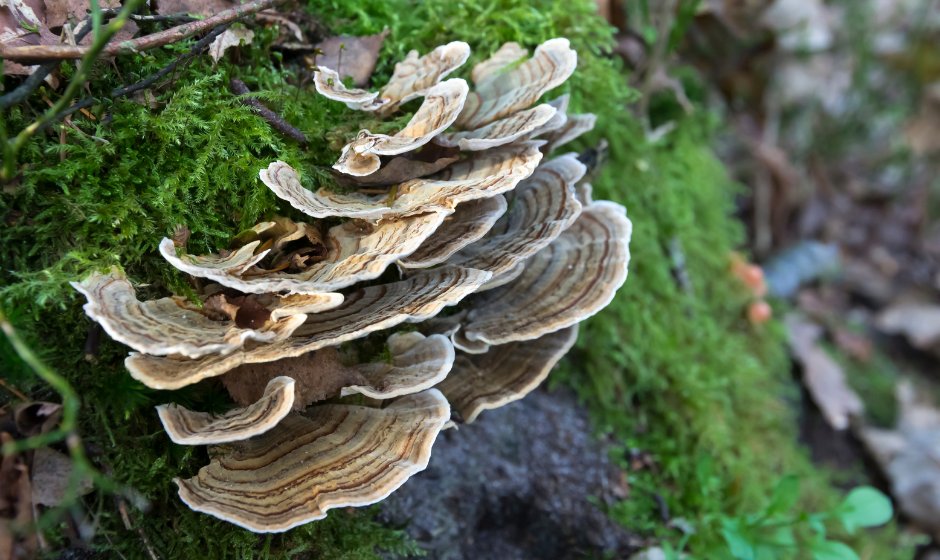
What Do Turkey Tail Mushrooms Look Like?
Every name for turkey tail refers to the same mushroom: A bracket fungus that grows in clusters of fan-like, stemless conks sporting numerous concentric rings of different colors, which can include brown, cream, white, red, orange, blue and black.[2] Each individual conk, also known as a fruiting body, is only 1 to 3 millimeters (~0.04 to 0.12 inches) thick and 2 to 8 centimeters (~0.7 to 3.93 inches) across, but the mushrooms can grow together in clusters that span much larger areas.
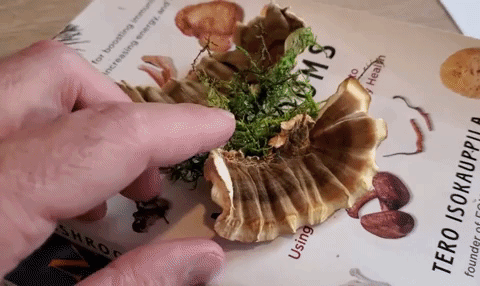
Similar to reishi, turkey tail mushrooms are polypores, which means they have no gills. Instead, a network of tubes on the underside serves as the delivery system for spores when the mushrooms to reproduce. Both the Boletus and Polyporus genus names describe this characteristic.[3,4] The spore side of the mushroom can be white, cream or light brown with between 3 and 8 pores per millimeter.[5]
Turkey tail mushrooms are pliable when young and become tough and woody as they mature. Cutting or breaking one of the conks reveals a white, rubbery interior surrounded by a surface that’s just a little fuzzy to the touch. Interestingly, coriolum means “small piece of leather” in Latin, which is another apt description![6]
Sound a little technical? It’s important to know all these details when identifying the mushroom. (More on that later.)
Where Do Turkey Tail Mushrooms Grow?
Clusters of turkey tail can be found pretty much anywhere around the world. The mushroom grows on dead or decaying wood in the U.S., U.K., Europe, Asia and Russia. It’s so common that it’s been reported to grow on over 70 types of hardwood in the U.S. alone—and it may also pop up on coniferous trees, which is unusual for mushrooms.
Like other fungi, turkey tail mushroom can either take up residence by depositing spores into fallen wood like logs or branches or invading a living tree that’s been damaged or stressed in some way. Decaying stumps are also fair game.
Living trees colonized by turkey tail develop a condition known as white rot, which occurs as enzymes from the mushroom break down lignins in the wood, leaving behind the cellulose.[7] Lignins are responsible for keeping trees rigid, so as the mushrooms transform them into sugars for food, the wood becomes soft and spongy.[8]
Turkey tail is usually found in groups of fan formations of varying sizes, which can look like layers of clam shells or small, rounded shelves. But—true to its name—this mushroom most closely resembles the shape and color of a turkey’s tailfeathers.
Turkey Tail Mushroom: Traditional Medicinal Uses
Mentions of turkey tail appear in The Divine Husbandman’s Classic of Materia Medica (also called Shen Nong Ben Cao Jing), a classic book of Chinese pharmacology compiled almost 2,000 years ago. Some of the material in it may date back as far as 476 BC![9] The text confirms that turkey tail was used as a folk treatment in Asia for centuries.[10] Other sources point to turkey tail’s use in Native American herbalism, as well.
Practitioners of traditional Chinese medicine believed this colourful mushroom could replenish “essence,” an energy or life force they thought was stored in the kidneys, as well a “universal” life force they dubbed “qi*.” It was also believed to clear a pattern of symptoms associated with inflammation, known in TCM as “heat*.”[11]
Turkey tail was commonly used to reduce fatigue, boost stamina, relieve joint pain, balance blood sugar, relieve coughs and asthma[12] and improve problems believed to be associated with spleen dysfunction—such as bloating vomiting, weakness and diarrhea*. Its association with spleen health may be one of the reasons why turkey tail was also considered to have beneficial effects on immune function*.
Today, TCM practitioners still use turkey tail mushroom to treat hepatitis, liver scarring, kidney inflammation (nephritis) and chronic fatigue syndrome*. Purified hot water extracts are used in combination with regular cancer treatments in Japan and may aid in combatting the unpleasant side effects of both chemotherapy and radiation, leading to better quality of life for cancer patients*.
What Makes Turkey Tail Mushrooms So Powerful?
There are at least five beneficial types of nutrients and active compounds that give turkey tail its medicinal characteristics:
- Polysaccharides—including beta-glucans—known as immunomodulators due to their balancing effects on the immune system
- Triterpenes, which are part of the mushroom membrane and act as precursors to natural steroids[13]
- Sterols, hormone precursors that include ergosterol and fungisterol; ergosterol is converted to vitamin D2 when exposed to sunlight
- Polyphenols, such as flavanoids, produced in response to environmental stressors and associated with positive benefits when consumed[14]
- Vitamins and minerals, including selenium, vitamin B3 and vitamin D—although the selenium content depends on how much selenium is available in the environment where the mushrooms grow
If these were the only compounds and nutrients in turkey tail, it would make for a pretty amazing combination. But there are two standout compounds that elevate turkey tail mushroom to superhero status: polysaccharide krestin (PSK) and polysaccharide peptide (PSP). Both PSP and PSK are polysaccharide-protein complexes: chains of many sugars bound to proteins at specific places in their molecular structures.
PSK was first isolated in Japan in the late 1960s from a strain of turkey tail known CM-101. The compound contains about 28 to 35% protein and 34 to 35% carbohydrates.
PSP, isolated in China in 1983 from the COV-1 turkey tail strain, is about 31% protein and 46% carbohydrates.
Both PSP and PSK contain alpha- and beta-glucans, as well as numerous amino acids like glutamine, which gives mushrooms their distinct “umami” flavor.[15] Both compounds are also associated with enhanced immune activity, although PSK usually gets more attention for its use as an adjunct treatment in cancer research*.
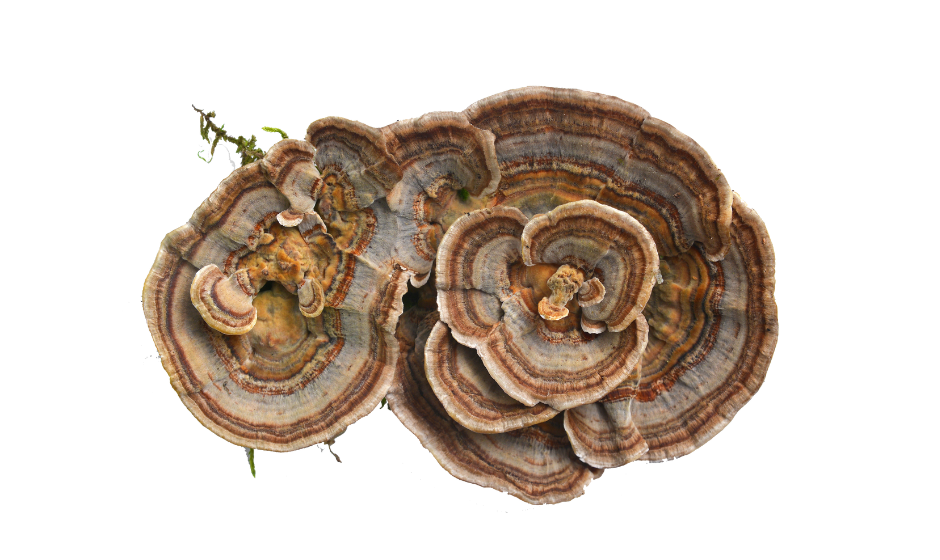
Turkey Tail Mushroom Benefits
Turkey tail stands out among medicinal mushrooms as one of the few that’s been used in multiple human clinical trials. In fact, PSK is approved in Japan for clinical use alongside traditional cancer treatments; the Chinese FDA has also approved the compound as a treatment for several conditions.[16]
Western science is beginning to catch up by conducting both human and animal studies of turkey tail’s key compounds. The research has uncovered at least 10 ways this mushroom could benefit health.
1) may prevent cell damage*
Like plants, mushrooms produce compounds called polyphenols as a natural defense mechanism. Polyphenols provide protection from UV rays, pathogens and other potential sources of attack or damage.[17] When people consume mushrooms or mushroom extracts, these same polyphenols can act as antioxidants*.
Antioxidants prevent cell damage and inflammation by neutralizing free radicals in the body. When unstable free radicals interact with healthy cells, it results in oxidative damage, which can cause signs of aging and increase the risk for age-related diseases. Antioxidants intercept this process and restore stability before damage can occur.
The polyphenol content of turkey tail is highest in the fruiting bodies, and alcohol extracts appear to offer the most antioxidant potential*.[18]
2) Stimulates and Balances Immune Responses*
Many compounds in turkey tail mushroom exhibit immunomodulatory effects, including polysaccharides and triterpenes*. PSP and PSK in particular have both been associated with better immune activity*.
Research shows several possible ways these compounds may improve the body’s natural immune response:
- PSK can activate natural killer cells, leading to more effective clearing of pathogens.[19]
- PSP can help immune cells recognize invaders and cell abnormalities, as well as activate beneficial pro-inflammatory responses to eliminate pathogens and keep cells healthy.[20]
- Turkey tail extracts can increase specific markers indicating an immune response—like tumor necrosis factor alpha (TNF-a), interferon gamma (IFN-y) and interleukin 12 (IL-12)—which may help the body defend against pathogens*.[21]
- Polysaccharides from turkey tail can activate antibody-producing B-cells and increase production of two specific antibodies: immunoglobulin M (IgM), which is made when fighting new infections, and immunoglobulin G1 (IgG1), which controls immune responses against viruses*.[22]
- Turkey tail may activate pro-inflammatory Th1 cytokines, which can cause autoimmune responses in some cases*. However, these same cytokines can be beneficial players in immune defenses when activated appropriately*.[23]
But turkey tail’s effects aren’t all about firing up the immune system*. Like other medicinal mushrooms, Trametes versicolor can promote balance*. One study showed cultivated turkey tail mycelium and its fermented substrate could increase both pro- and anti-inflammatory cytokines, possibly by activating a protein called CD69 involved in signaling between immune cells*.[24]
These immune system benefits appear to help healthy individuals, as well as people with low immune function*.[25] It’s also interesting to note that some effects on immunity differed between studies done in petri dishes (in vitro) and those conducted on animals or humans (in vivo), which suggests the holistic benefits of turkey tail may be greater than those observed in isolated environments*.
3) may modulate Inflammation*
Because they may prevent damage to cells and tissues, antioxidants in turkey tail mushroom can reduce the potential for inflammation*. Reducing inflammation may also protect against conditions like heart disease, which is believed to be associated with chronic inflammatory responses*.
Turkey tail’s main medicinal compounds—beta-glucans, triterpenes and sterols—have also been shown to exhibit anti-inflammatory effects*. Both isolated compounds and extracts from the mushroom appear to reduce production of pro-inflammatory cytokines like TNF-a, nitric oxide (NO), and interleukin-6 (IL-6)*.[26] When cells are in pro-inflammatory environments, extracts may also lower the levels of compounds associated with the stimulation of inflammatory responses*.[27]
One interesting study illustrated another potential benefit by looking at arthritic rats with morphine tolerance Rats treated with PSP didn’t develop dependence on the painkiller as easily and experienced less intense withdrawal symptoms. The morphine also appeared to be more effective overall.
How did it work? It seems the turkey tail activated a specific cannabanoid receptor while increasing beta-endorphins. Together, these effects can change the way the body perceives pain. Additional reduction of pro-inflammatory compounds also played a role.[28]
However, some studies on turkey tail show opposite effects. At certain doses, compounds from the mushroom may increase pro-inflammatory responses.[29] This indicates a potential balancing effect similar to the way turkey tail acts on the immune system and suggests different doses may be required to address specific conditions.
4) May Improve Cholesterol and Prevent Obesity*
In a study on mice with high cholesterol, extracts from turkey tail mushroom lowered total blood cholesterol levels, including triglycerides and LDL*. The effect may be due, at least in part, to an increase in lipoprotein lipase, an enzyme that breaks down triglycerides in the body.[30]
Other evidence suggests a compound called protein-bound beta-glucan (PBG) might help prevent weight gain by increasing levels of Akkermansia muciniphila, a bacterium that lives in the gut*. The presence of Akkermansia muciniphila is correlated with lower levels of inflammation, which could play a role in creating a healthier gut barrier and preventing proteins or pathogens from crossing into the bloodstream and triggering immune responses*. The bacterium is also associated with better insulin sensitivity, which seems to be an important factor in weight management*.[31]
The study that examined PBG’s effects showed that transplanting the microbiomes of mice treated with PBG into the guts of mice fed high-fat diets appeared to make the gut environment friendlier to Akkermansia muciniphila. PBG also had an effect on genetic responses related to metabolism, which led to better weight control*.[32]
5) Could Improve Exercise Endurance*
When scientists gave mice an extract from the mycelium of turkey tail mushroom for four weeks, the mice showed improvements in several markers related to exercise fatigue*. Three byproducts of exertion—lactate, ammonia and creatine kinase—were lower in treated mice than in controls. Mice receiving the turkey tail extract also exhibited stronger grip strength*.[33]
These results suggest the treated mice experienced less muscle damage during exertion and may also have been able to use oxygen more efficiently*. No toxicity was observed despite the high dosage, which was about the equivalent of 4 to 21 grams of turkey tail per day for a person of average weight*. However, more research is needed to know whether the same effects can be replicated in humans.
6) May Combat Chronic Fatigue Syndrome*
Chronic fatigue syndrome (CFS) is an idiopathic condition with a wide range of symptoms, which can include lack of refreshing sleep, problems with memory, difficulty concentrating, muscle and joint pain, headaches, dizziness, moodiness, swollen lymph nodes and exhaustion after mild exertion.
Although the exact cause of CFS remains unknown, suggested causes include viral infection, immune disorder, extreme stress and hormonal abnormalities.[34] The condition officially qualifies as “chronic” if symptoms persist for a month or more.
A study in the Journal of Integrative Medicine examined whether turkey tail mushroom could provide relief from CFS. In the study, 36 people with the condition took an extract from a turkey tail strain called CV-OH1 for two months. At the end of the study, levels of natural killer (NK) cells increased by 45%, and participants also exhibited various levels of T-cell activation and suppression*. Low NK cell levels and low T-cell activation have been found in some CFS patients,[35] so the turkey tail extract may have been working to balance the immune system*.
Since both infection and autoimmunity have been suggested as potential causes of CFS,[36] the results of this study could mean turkey tail mushroom has a potential role to play in CFS treatment by boosting or suppressing immune responses as needed*.
7) Offers Potential Liver Protection*
Turkey tail’s antioxidant and immunomodulatory effects may guard against alcohol-induced liver injury*.[37] PSP may also protect liver cells by helping the body maintain its own levels of an antioxidant called glutathione*. This was shown in a model of liver injury in rats where those receiving PSP had lower levels of two blood markers indicating liver cell damage: serum glutamic pyruvic transaminase (SGPT) and glutamic oxaloacetic transaminase (SGOT).[38]
Another study on a rodent model of liver cancer showed fractions from turkey tail mushrooms were able to inhibit cancer cells while restoring and stimulating the recovery of normal liver cells*.[39]
What About Turkey Tail and Hepatitis?
It’s possible that turkey tail mushroom could be beneficial in addressing liver damage from hepatitis, as well: PSP has been used in China for years to threat hepatitis shows promise when combined with other treatments from traditional Chinese medicine*.[40]
PSP may also reduce adverse reactions and improve patient outcomes when used along with interferon, a common pharmaceutical treatment for hepatitis*.
8) Has Antibacterial and Antiviral Properties*
Compounds in turkey tail can interact with the immune system to provide protection against bacteria and viruses in several ways:
- Beta-glucans may kill bacteria by boosting the body’s production of nitric acid*[41]
- Alcohol extracts from cultivated turkey tail may damage bacterial cell membranes or prevent bacterial cell division to stop bacteria from multiplying*[42]
- PSK can boost antibody-producing B-cell activity and improve survival rates even when white blood cell counts are low*[43]
9) May Promote Better Gut Health*
A handful of studies suggest supplementing with turkey tail mushroom could improve gut health by combatting inflammation and supporting beneficial bacteria*.
One study looked at how PSP affects the microbiome when compared to the antibiotic amoxicillin.[49]. Twenty-four people were randomized into three groups—PSP, antibiotics and control—for eight weeks. Stool analysis showed that PSP had prebiotic effects, which can include increasing “good” microbes in the gut*.[50] The amoxicillin group, on the other hand, had an increase in pathogenic bacteria that persisted for 42 days after they stopped taking the antibiotic.
Similar results were seen when PSP was combined with a type of complex carbohydrate called fructooligosaccharides (FOS) in a culture medium along with microbes commonly found in the human gut:[51]
- Beneficial Bifidobacterium and Lactobacillus species increased
- Pathogenic Clostridium, Staphylococcus and Enterococcus bacteria decreased
- More short-chain fatty acids (SCFAs) and lactate were produced, which can feed “good” gut bacteria[52] and keep the gut lining healthy[53]
Turkey tail’s anti-inflammatory effects may provide additional benefits in cases of inflammatory bowel disease (IBD)*. Mice with ulcerative colitis given extracts from the mushroom had lower levels of inflammatory cytokines like TNF-a and IL-6*. The extracts also appeared to interfere with the production of IFN-y and IL-4 cytokines.[54]
Taken together, these studies suggest the antibacterial, antiviral and immunomodulatory activities of turkey tail could improve the gut microbiome and help maintain a healthier gut environment*.
10) May Have Beneficial Effects for Cancer Patients*
Although PSK from Trametes versicolor has been used in Asia alongside traditional cancer treatments for decades, it hasn’t yet been incorporated into mainstream clinical use in the Western world. But studies continue to be conducted, some of them in humans, which is an exciting development given that most medicinal mushroom research to date has focused only lab animals or isolated cell cultures.
In some of the studies, turkey tail mushroom appears to work as a biological response modifier (BRM), literally modifying the immune response to better equip the body to target and clear cancerous cells*.
It’s also possible that the mushroom’s anti-inflammatory and antioxidant activity may prevent cellular damage that can lead to cancerous abnormalities*.
How Might Turkey Tail Work Against Cancer?
The current body of research suggests several potential mechanisms of action to explain the correlation between turkey tail and better outcomes for cancer patients:
- PSK appears to improve the immune response by increasing white blood cell activation and upregulating key cytokines while also interfering with enzymes involved in the process of metastasis*[55]
- Antioxidants may protect tissues against initial damage from carcinogens and from the secondary effects of chemotherapy and radiation*
- PSP could improve the body’s natural defenses against cancer by improving how immune cells work, increasing both chemokines and cytokines and helping dendritic cells and T-cells eliminate cancer cells*[56]
- PSP may increase macrophage function to better clear tumor cells when used in conjunction with other cancer treatments*[57]
- PSK appears to prevent cancer cells from dividing out of control by interfering with early stages of the cell cycle, resulting in cancer cell death*[58]
- A unique lipid in turkey tail mushroom may work with PSK to increase its uptake and also positively interact with toll-like receptor 2 (TRL2) proteins,[59] which help the body recognize pathogens and can prompt the immune system to attack cancerous cells*[60]
These effects may explain why one meta-analysis of people receiving turkey tail along with traditional cancer treatments in clinical trials had a 9% reduction in five-year morality rates—particularly those with breast, gastric and colorectal cancers*.[61]
However, not every study involving turkey tail mushroom and cancer shows beneficial results. Continued research is needed to determine the best ways to prepare and administer the active compounds for optimal outcomes.
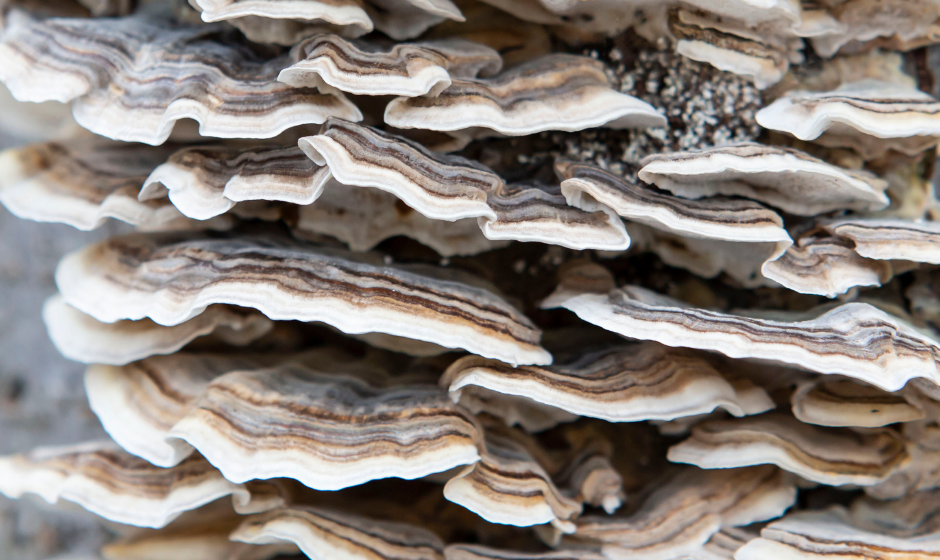
Identifying and Harvesting Wild Turkey Tail
The ubiquity of Trametes versicolor means it’s not hard to find. Anywhere with fallen wood and dead or decaying trees is fair game. If the mushrooms have been growing for a while, it’s possible to find huge clumps covering stumps or fallen logs.
Autumn and winter are the best times of year to seek out wild turkey tail mushroom. This is when the mushrooms release their spores, so it gives them time to reproduce before being harvested. To get the best specimens, look for white or cream-colored rings at the edges of the conk.
(Remember to leave some behind for other foragers!)
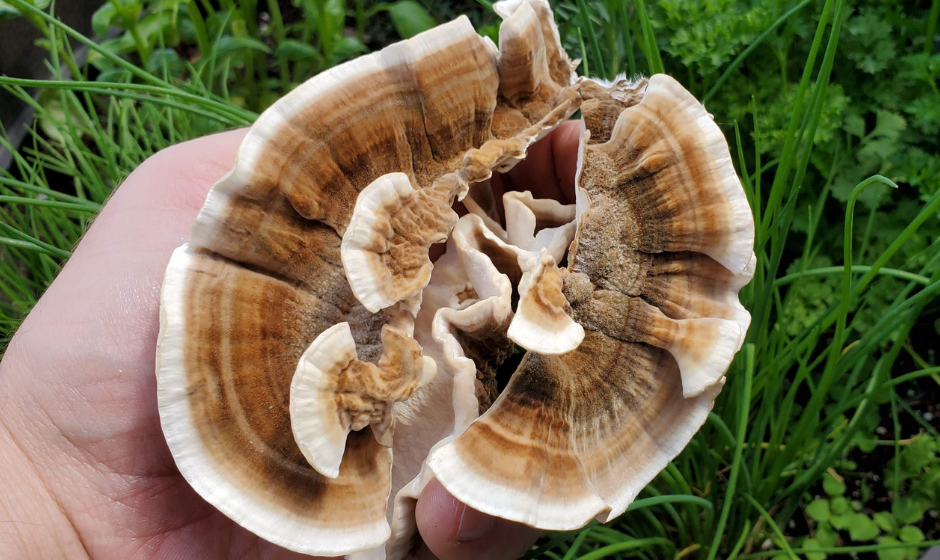
Is it Really a Turkey Tail Mushroom?
There are three main ways to tell turkey tail apart from other wild mushrooms:
- Color. Other species in the Trametes genus lack clearly separated, contrasting zones of color on top of the conk.
- Pore size. Turkey tail mushroom pores are very small and harder to distinguish than those of similar mushrooms.
- Fuzz. Turkey tail should look just a little hairy and feel velvety to the touch.
Use these cues to find the right polypore when trekking through the woods on a mushroom hunting expedition. As always with wild mushrooms, you want to be 1000% sure you know what you have identified, especially if you are planning to ingest it in any form. If you have doubt, throw it out. Best bet is to go with someone you trust that knows how to find them, or go on an expedition with your local mycological society.
5 Types of False Turkey Tail
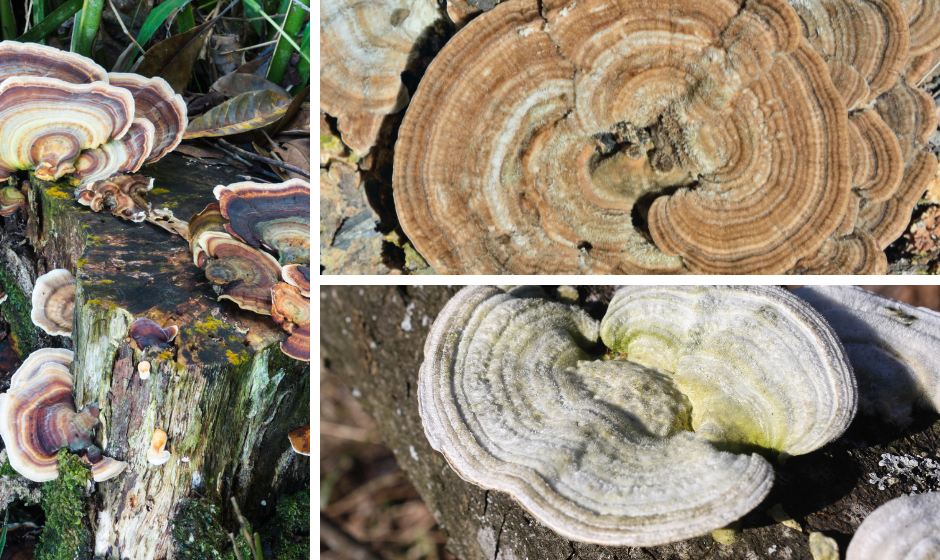
These “fraternal twins” of turkey tail can cause confusion for budding foragers:
- Stereum ostrea, the unofficial “false turkey tail,” is a type of mushroom called a crust fungus with color bands on top but no pores. Instead, the underside is flat and has a red, tan or brown color, and the top tends to curl more than true turkey tail.
- Trametes hirsuta, the “hairy” bracket fungus, is white or gray, lacks distinct color bands and has quite a bit of fuzz.
- Tremetes pubescens sports concentric rings of color, but they’re much less striking than Trametes versicolor; this mushroom also doesn’t grow on soft wood.[89]
- Trichaptum biforme, a fan-shaped fungus that grows in clusters and has a violet tinge around the edge and on the underside. The top is slightly fuzzy with areas of white, brown and black,[90] and fully grown specimens tend to be smaller than Trametes versicolor.
- Trametes ochracea becomes hard when it’s still small, whereas turkey tail retains some flexibility.
Fortunately, none of these lookalikes are poisonous. Some simply taste bad, and it’s not known whether they have any of turkey tail’s benefits. However, it’s still best to be cautious and not consume or use any mushroom that hasn’t been positively identified as edible or medicinal.
Growing Turkey Tail at Home
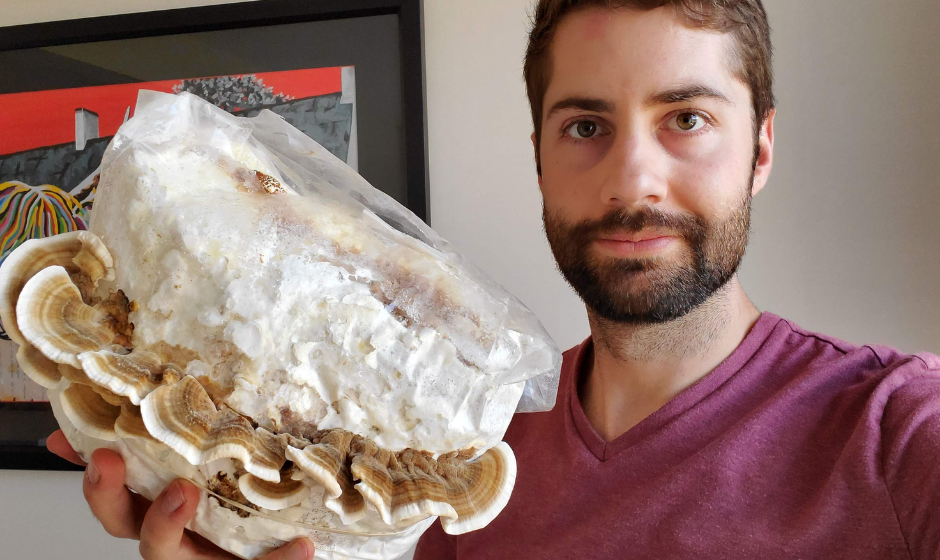
Because turkey tail mushroom grows just about everywhere, most supplements are made from wild-harvested specimens. But aspiring mushroom hunters who don’t have access to good foraging spots can grow turkey tail using a kit or substrate and spawn. Common substrates include grain and sawdust, although it’s also possible to start with a log.
You can use many of the other strategies for gourmet and medicinal mushrooms that will work well for Turkey Tail. If you are interested in growing yourself, check out our guides to growing mushrooms.
Trametes versicolor likes moderate temperatures and high humidity and takes one to two months to grow to maturity. Once fully grown, the conks can be used to make tea, broth or tinctures.
Turkey Tail Dosage and Use
Turkey tail is a pretty easy mushroom to incorporate into a daily routine, whether by tossing some powder into a smoothie or brewing dried conks to make a relaxing cup of tea.
A good starting dose is 1 gram of powdered turkey tail supplement per day. Capsule and tincture doses vary and can be found on the manufacturer’s supplement facts panel.
Taking up to 3 grams of turkey tail per day is recommended for immune support; 3 grams to 6 grams per day may provide additional benefits during illness and recovery*. Studies on PSP and PSK used 3 grams to 4 grams of extract to deliver the beneficial polysaccharides*.[92]
While some sources suggest that up to 9 grams of turkey tail per day is safe and effective, it’s best to start with the lowest dose and increase slowly until the desired effect is achieved*. Break doses up throughout the day when taking larger amounts.
Note: Remember that turkey tail mushroom isn’t a treatment. Research on its benefits is still underway. Always check with a doctor prior to supplementing, especially when taking other medications.
Choosing Turkey Tail Supplements: Mushrooms Made from Mushrooms
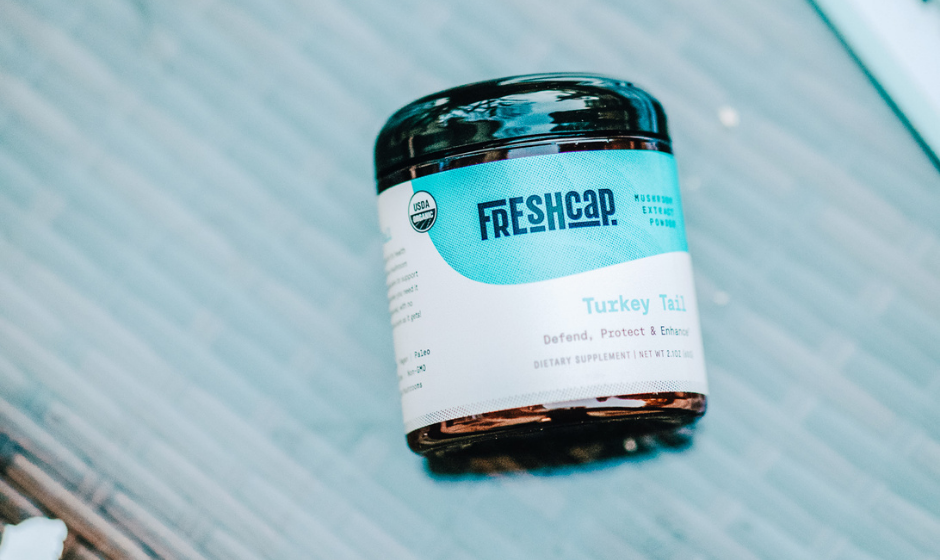
Quality directly influences how effective a turkey tail mushroom supplement will be. Supplements made from wild-harvested or cultivated fruiting bodies offer the highest amounts of beneficial compounds.
Another common way to make turkey tail supplements is to grow just the mycelium on grain. The resulting product usually costs less, but it also lacks the potency of a fruiting body supplement. Any medicinal compounds in the mycelium get diluted by the high ratio of grain that winds up in the supplement during processing.
For turkey tail, it’s also important to look for supplements that have undergone extraction. This unlocks all the medicinal compounds from the cells of the mushroom to deliver the full spectrum of effects.
Supplements are available in health food and natural product stores, as well as online. Read reviews and check company reputations before purchasing to ensure the product contains what it claims.
Turkey Tail Mushroom Side Effects and Risks
Supplementing with turkey tail is considered safe and causes few or no side effects in most people. PSP and PSK extracts have been used in cancer patients without a problem at levels of 1 gram or more per day for as long as 10 years. No data is available to indicate what, if any, dose may cause toxicity.
Some people may experience mild side effects when taking turkey tail mushroom, including:[93]
- Heartburn
- Constipation
- Nausea
- Chest pain
- Symptoms similar to cold or flu
Others have reported diarrhea, dark stool and darkened nails.[94]
Patients using PSK in combination with chemotherapy may experience nausea, vomiting, low white blood cell counts and liver problems.[95]. However, these may also be side effects of the chemotherapy itself, which makes it difficult to know if PSK plays a role.
When Not to Take Turkey Tail
People with mushroom allergies and women who are pregnant or nursing should avoid turkey tail mushroom supplements. And although there are no known drug interactions, it’s important to discuss any potential concerns with a doctor before combining medicinal mushrooms with prescriptions.
Is Turkey Tail Safe for Dogs?
Many dog owners swear by turkey tail to boost their furry friends‘ health. And there is one study to suggest they might be on to something*.
In 2012, the makers of a PSP supplement called I’m-Yunity funded a double-blind randomized study that assigned dogs with a blood vessel cancer called hemangiosarcoma to receive either 25, 50 or 100 milligrams of the supplement per day*.
At the end of the study, the highest dose delayed the progression of metastasis compared to lowest dose, and there was a dose-dependent increase in survival time compared to previously recorded median survival times for dogs with this type of cancer*.[96]
Because the study was funded by the supplement maker and there was no placebo group, it’s difficult to know how reliable these findings are. However, since PSP has exhibited the ability to boost immunity and interrupt the lifecycles of cancer cells in other studies, it’s possible these effects were at work in the dogs.
Is Turkey Tail an Edible Mushroom?
Turkey tail’s tough texture makes it less than appetizing as a culinary mushroom. Technically it can be eaten since it’s not poisonous, but there are easier—and less rubbery—ways to get the benefits.
How to Prepare Turkey Tail Mushrooms
Wild-foraged mushrooms need to be cleaned before using or storing.
Start by brushing the dirt off using a soft kitchen brush, toothbrush or damp paper towel. Check each mushroom for mold and cut away anything that doesn’t look right, including bits of bark or wood still clinging to the conk.
Clean mushrooms may be used immediately or dried for storage. To dry:[97]
- Place turkey tail mushrooms on dehydrator trays and dehydrate at 35 to 38 C (95 to 100 F) for 24 to 36 hours. Rotate the trays approximately every eight hours to ensure even drying.
- Alternatively, set the oven at 77 to 93 C (170 to 200 F). Arrange the mushrooms on baking sheets and dry for 24 hours, leaving the oven door cracked and rotating the trays occasionally.
Dried mushrooms can also be purchased online from reputable sources. Look for wild-harvested or organic specimens—or contact a local mycological society to see if any foragers in the area have some for sale!
Store dried turkey tail in an airtight container away from light and heat.
Making Turkey Tail Mushroom Tea
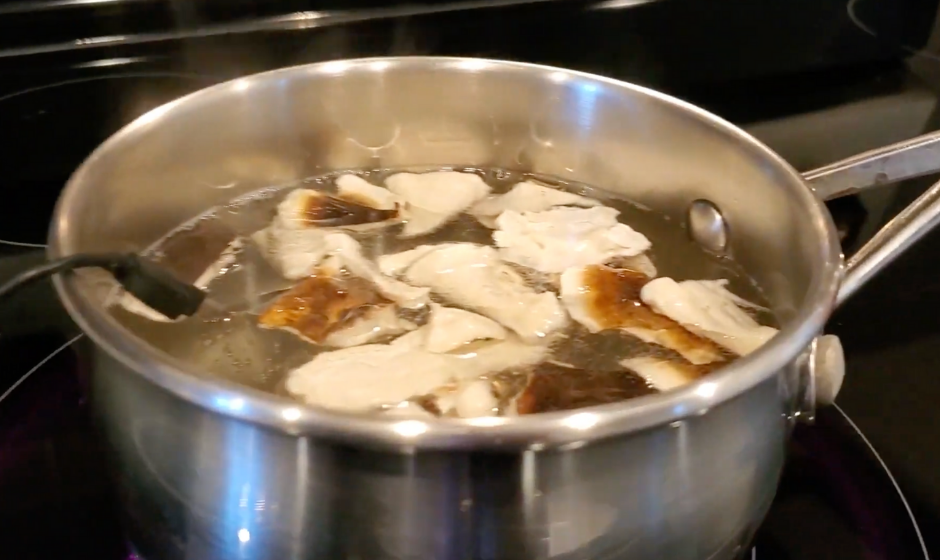
Turkey tail has a milder flavor than other medicinal mushrooms, which makes it a good candidate for tea. To brew a batch from fresh or dried mushrooms:
- Measure out 5 cups of water for every 1 cup of turkey tail.
- Place the water in a large saucepan, and bring it to sub boiling temps (80 degrees C is best)
- Reduce the heat to a simmer before adding the mushrooms.
- Simmer for at least an hour (several hours is preferable).
- Remove the tea from the heat, and cool completely.
- Strain out the mushrooms, and store the tea in a jar in the fridge.
For a “set it and forget it” tea: Place dried turkey tail and water in a slow cooker or Instant Pot and cook on low for 6 to 8 hours before cooling and straining.
Preparing turkey tail this way basically results in a homemade water extract that contains beneficial mushroom polysaccharides. Enjoy a cup every day hot or cold, with or without natural sweetener. Adding other ingredients, such as turmeric, may boost the anti-inflammatory and immunomodulatory effects.
Turkey tail tea also makes a great broth for soups and stews, particularly dishes that can benefit from a boost of umami flavor.
Turkey Tail Mushroom Recipes
The mild flavor of a turkey tail powder or extract makes it easy to “hide” this mushroom in a variety of tasty dishes. Give it a try with these recipes for breakfast, snacks and refreshing beverages:
- Immunity Pumpkin Waffles
- Immune Supporting Turkey Tail Granola Mix
- Turkey Tail and Brazil Nut Immunity Booster
- Turkey Tail Turmeric Lemonade
Make Turkey Tail Mushroom Part of Your Day
With its low risk of toxicity and unique effects on both pathogens and cancerous cells, turkey tail has a lot of potential as a future treatment alongside traditional therapies*.
Science is only beginning to uncover the possibilities this mushroom has to offer. PSP and PSK may only be the tip of the iceberg; it’s possible other compounds in turkey tail may work together with these special polysaccharides to produce even greater effects.
So go ahead, check out a nearby forest or park to see if you can spot some colorful turkey tail mushrooms sprouting on a log. Bring a few home for making tea, or try a daily supplement for a supercharged wellness boost.
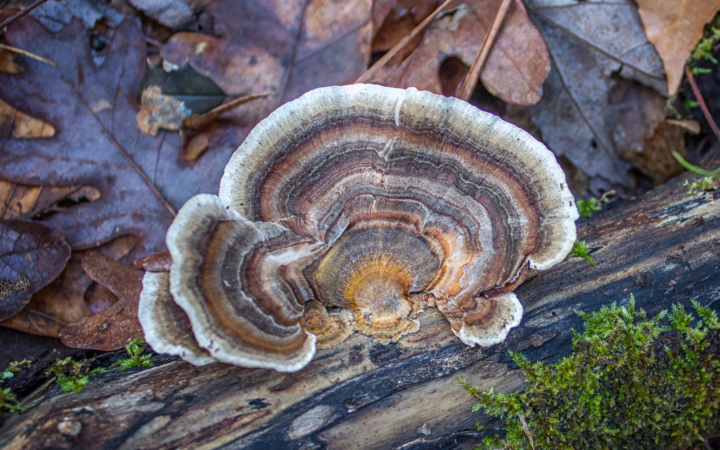
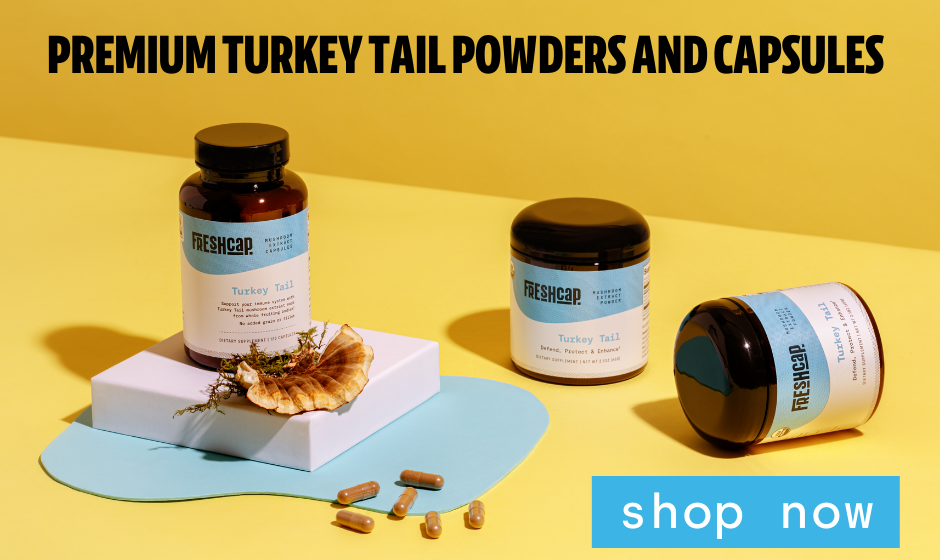
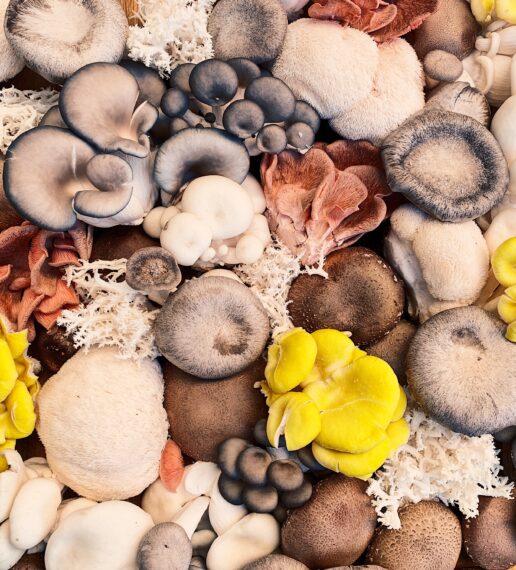

Great article, very informative. Thank you. Maybe you can do an article on chaga too?
Glad you like it! We actually do have an ultimate guide to Chaga- (https://learn.freshcap.com/tips/chaga-mushroom-guide/)
Enjoy!
Hi Tony, I loved the video on this. I am in the search of books on wildcrafting medicinal. Do you happen to have a book on mushrooms with all of your accumulative knowledge on mushrooms? Or an ebook? Again, thank you for your sharing of your knowledge and uses of mushrooms. Happy fall!
Being a woods person and having previous knowledge before reading this article, I’ve been using Turkey tails for several years. Once harvested checked and cleaned they are stored in the refrigerator for use. What I do is put a fan sized portion into my coffee cup and let it sit a few minutes before drinking. I believe my health is maintained by this use. Though this article is well written it does contain many of the what I consider to be ify words which is ok but demonstrates that more studies need to be done to make it solid fact.
A great article on turkey tail! I have harvested turkey tail in British Columbia for a few years now and I have tried different ways of preparing tea. As I have made it a regular part of my daily regimen, I was wanting the simplest way of preparing the tea. Up until now, I’ve used a coffee grinder to pulverize the brackets but it’s quite tough and hard on the coffee grinder. I’d store this and add a teaspoon to a hot water tea that I leave to steep overnight. But, you gave me an idea that I wanted to pass by you. I’d like to borrow your method of steeping broken up pieces being on a low simmer for several hours – but I wondered if this could be cooled and frozen into ice cubes and stored in the freezer for longer periods of time. What do you think?
Hi Gideon, freezing cubes of extracted turkey tail liquid for later use should work great!